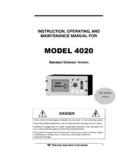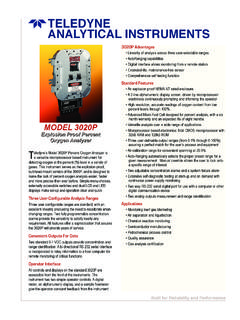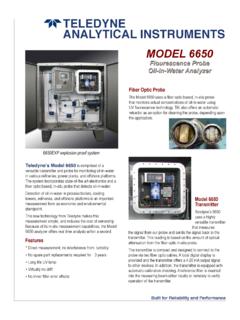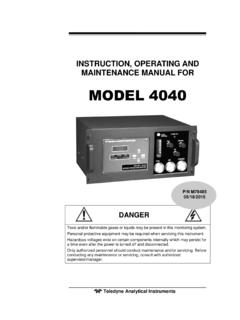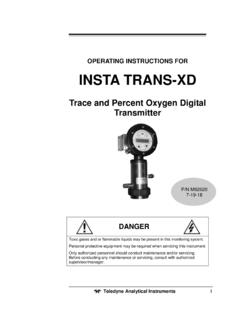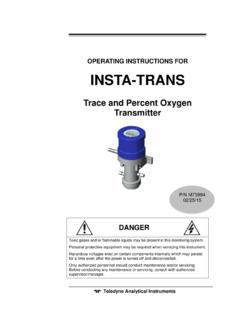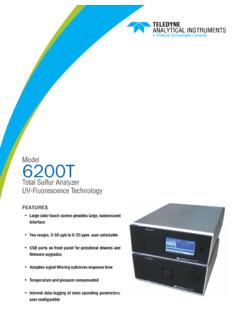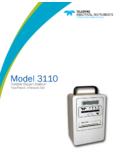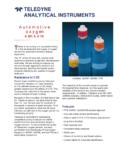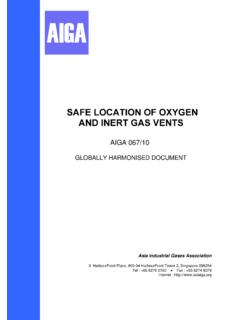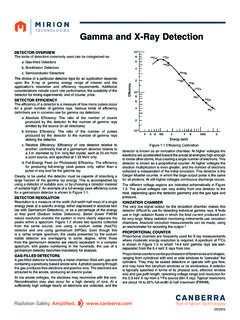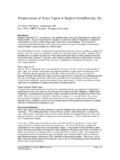Transcription of Sensors for Gas Phase Oxygen Analysis
1 IntroductionOf all gases, Oxygen plays a unique part in humanexistence. Without it, life as we know it could not nature and measurement of Oxygen has,therefore, always been an important challenge technological advances both in industry andmedicine have resulted in an increased demand foraccuracy in Oxygen measurements. The application ofoxygen analyzers ranges from the measurement of theatmosphere inside an incubator containing apremature baby to the monitoring of the oxygencontent of process and combustion streams in giantchemical plants and refineries to insure safe andeconomical is the intent here to discuss in detail TAI's Micro-fuelCell, an electrochemical Oxygen transducer aroundwhich an entire line of analyzers has been developedand successfully marketed.
2 At the end of thisdiscussion, the principle of operation of other oxygenanalyzers will be reviewed and comparisons of eachanalysis technique, relative to that of the Micro-fuelCell, will be Micro-fuel CellTAI's Micro-fuel Cell is an electrochemical is a device that converts one form ofenergy to another. For example, a loudspeaker is atransducer that converts electrical energy intomechanical energy (sound). A microphone is atransducer that is the reciprocal of this; mechanicalenergy is converted to electrical for Gas Phase Oxygen Analysisby Jay Lauer, Development EngineerAbstractAdiscussion of gas Phase Oxygen Analysis is presented. Particular emphasis is given to the construction, principle ofoperation, and performance characteristics of the various types of Micro-fuel Cells manufactured by TeledyneAnalytical instruments (TAI).
3 Micro-fuel Cell is the trade name for TAI's disposable electrochemical , non-disposable trace level Oxygen sensor is discussed. The additional requirements and specialcalibration techniques related to analyzers utilizing this type of Oxygen sensor are described. Finally, other analysistechniques are summarized and comparisons most common electrochemical transducer is abattery which transforms chemical energy intoelectrical energy. Although less well known, a fuel cellperforms the same transformation. The primarydifference between a battery and a fuel cell is theplace where the chemical energy is stored. In theinstance of batteries, the chemical energy is storedinside the device itself. With fuel cells the chemicalenergy is stored externally; the rate at which thechemicals are fed into the fuel cell determines theamount of energy or power that is of OperationThe Micro-fuel Cell then is a fuel cell (strictly speaking,a hybrid fuel cell) where part of the chemical energy isstored within and the other chemical reactant ( Oxygen )comes from outside the device.
4 Most fuel cells arepower devices, the hydrogen- Oxygen fuel cells thatare used to power the manned space vehicles used byNASA in the space program. The Oxygen sensing cellunder discussion here provides power normally in the1 to 200 microwatt range, hence the name types of electrochemical transducers have threemajor component parts; an anode, a cathode, and anelectrolyte. In the Micro-fuel Cell, the cathode is thesensing electrode or the site where Oxygen is + O2 + 2H2O -------> 4OH- (1)In the above reaction, four electrons combine with oneoxygen molecule (in the presence of water from theelectrolyte) to produce four hydroxyl ions. Thiscathodic half-reaction occurs simultaneously with thefollowing anodic half reaction:Pb + 2OH- -------> PbO + H2O + 2e- (2)The anode (lead) is oxidized (in a basic media) to leadoxide and in the process two electrons are transferredfor each atom of lead that is sum of half-reactions (1) and (2),O2 + 2Pb -------> 2 PbO (3)results in the overall reaction (3).
5 From this reaction itcan be seen that the Micro-fuel Cell should be veryspecific for Oxygen providing there are no gaseouscomponents in the sample stream capable of oxidizinglead. The only likely compounds that meet thisrequirement are the halogens (iodine, bromine,chlorine, and fluorine.)Physical ConstructionThe Micro-fuel Cell (Figure 1)is designed as adisposable unit and when the lead anode is consumeddue to the sensing of Oxygen , the cell is simplydiscarded. The cell is, therefore, maintenance freerequiring no replacement of membranes or electrolyteand no cleaning ofelectrodes. It is about "in diameter and .75" rear of the cell is fittedwith a contact platecomposed of two concentricmetal foils which areelectrically common to theanode and cathode andmate to spring loadedcontacts in the various cellholding devices usedthroughout the product anode is composed oflead and is configured insuch a manner (proprietary)so as to maximize theamount of metal availablefor reaction.
6 The cathode isa convex metal discapproximately .75" indiameter with numerousperforations to facilitate continued wetting of the uppersurface with electrolyte and assure minimum internalresistance during the Oxygen sensing reaction. Theexternal surfaces of the cathode are plated with aninert or noble metal, normally gold. Silver, rhodium,and platinum are also used in special rear of the cell (inside the contact plate) is fittedwith a flexible membrane that is designed toaccommodate internal volume changes that occurthroughout the life of the cell. If it were not for thisvolume compensating membrane, the membranecovering the cathode would move to accommodate theinternal volume changes resulting in changes in outputnot related to Oxygen sensing membrane (covering the cathode) ismade of Teflon whose thickness is very accuratelycontrolled.
7 The entire space between these twomembranes is filled with electrolyte (an aqueoussolution typically of potassium hydroxide). This resultsin all surfaces of the anode and cathode being"bathed" in a common pool of main body of the cell is fabricated from highdensity polyethylene. This results in an Oxygen sensorthat can be placed in virtually any atmosphere orsample stream without any concern that thecomponents of the sampled media will react with thecell MeasurementsIn reaction (1) four electrons are transferred for eachoxygen molecule undergoing reaction. In order to bereacted, an Oxygen molecule must diffuse throughboth the sensing membrane and the thin film ofelectrolyte maintained between the sensing membraneand the upper surface of the cathode.
8 The rate atwhich Oxygen molecules reach the surface of thecathode determines the electrical outlet. This rate isdirectly proportional to the concentration of Oxygen inthe gaseous mixture surrounding the in Figure 2, this proportionality is linear with thesensor exhibiting an absolute zero, in the absenceof Oxygen the cell produces no :Given these two conditions (linearity andabsolute zero), single point calibration is possible. Theoxygen concentration in air ( ) is a veryconvenient reference gas to use, and it is accurate tothree or four significant figures throughout the entireearth's calibrating a given Oxygen analyzer, it is best to usea calibration or reference gas whose Oxygen content isnear or equal to the full scale reading.
9 In Figure 2,both air and 100% Oxygen are shown as potentialcalibration gases. In theory, any known concentrationof Oxygen could be used. Air and 100% Oxygen werechosen because they are the easiest and mosteconomical to obtain. In this case, however, air is notthe better of the two gases to use for calibration. Anyerror in reading the readout meter or an error in themeter reading during the setting of the span controlwould be multiplied by a factor of 5 for subsequentreadings at or near full scale. This results fromattempting calibration at a point only 1/5 of full this case, 100% Oxygen would be the calibrationgas of air is such a convenient reference and theMicro-fuel Cell's readings are independent of thesample gas' flow rate (they can give accurate readingin static gas samples such as ambient air), multipleranges are generally provided in the moresophisticated instruments, one of which is always 0 25%.
10 Is about 84% of full scale which willprovide good calibration accuracy which is degradedonly slightly when switching to the other Units:Although most of the oxygenanalyzers manufactured by TAI are set up to readoutthe concentration of Oxygen in percentage units, theMicro-fuel Cell (and allother Analysis techniques)are actually sensitive tothe partial pressure ofoxygen in the sample gasmixture. Readouts inpercent are permissibleonly when the totalpressure of the gas beinganalyzed does not illustrate, assume thatan analyzer with a percentreadout was calibrated inair at sea level. The spancontrol would be adjusteduntil the analyzer readingwas (assumingthat degree of readabilitywas available). If theanalyzer were thenelevated to higher andhigher altitudes, thereading would begin to drop and continue to do so aslong as the analyzer is raised.
